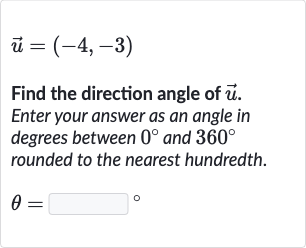Full solution
Q. Find the direction angle of . Enter your answer as an angle in degrees between and rounded to the nearest hundredth.
- Calculate Slope: To find the direction angle of the vector , we need to calculate the angle that this vector makes with the positive x-axis. The direction angle, often denoted as , can be found using the arctangent function () of the slope of the vector, which is the ratio of its y-component to its x-component. The formula to find the direction angle is .
- Use Arctangent Function: First, we calculate the slope of the vector by dividing its -component by its -component. For , the slope is .
- Adjust for Quadrant: Next, we use the arctangent function to find the angle that corresponds to this slope. However, since the vector is in the third quadrant (both and components are negative), the angle given by the arctangent function will be in the fourth quadrant. We need to add to this angle to get the correct direction angle in the third quadrant.
- Calculate Arctangent: Now, we calculate the arctangent of using a calculator.
- Add °: Finally, we add ° to the angle we found to get the direction angle in the correct quadrant.
More problems from Inverses of sin, cos, and tan: degrees
QuestionGet tutor help
QuestionGet tutor help
QuestionGet tutor help
QuestionGet tutor help
QuestionGet tutor help
QuestionGet tutor help
Question
. Find the value of in degrees.Write your answer in simplified, rationalized form. Do not round.____
Get tutor helpQuestionGet tutor help

